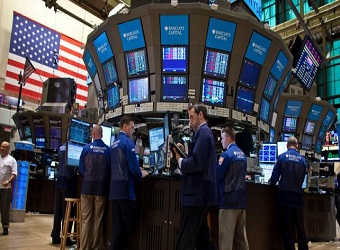U.S. stocks rose in choppy trade on Friday following a strong jobs report, while investors were already looking ahead to a Federal Reserve meeting next week.
The Dow Jones industrial average gained around 45 points, with UnitedHealth Group contributing the most gains. The S&P 500 gained a third of a percent, with utilities outperforming. The Nasdaq composite advanced 0.4 percent.
The major indexes, however, posted weekly losses, with the S&P and Nasdaq snapping six-week winning streaks. The Dow snapped a four-week winning streak.
The Fed is scheduled to meet next week with most market participants expecting the central bank to tighten U.S. monetary policy. According to the CME Group’s FedWatch tool, market expectations for a March rate hike stood at 93 percent.
“The jobs report is old news now. We’re all looking ahead to the rate hike,” said JJ Kinahan, chief market strategist at TD Ameritrade. He also said: “I think people may be taking a bit of risk off the table ahead of some major global news.”
The Netherlands is also scheduled to hold an election Wednesday. While the French contest is grabbing all the headlines in Europe, the Dutch election may serve as a bellwether for Europe’s future.
“In and of itself, I don’t think this will be a market-moving event, but if this populist trend continues, … that could have some broader implications for Europe and could cause volatility in the market,” said Michael Arone, chief investment strategist at State Street Global Advisors.
In U.S. economic news, 235,000 jobs were added in February, the Bureau of Labor Statistics said, adding the unemployment rate ticked lower to 4.7 percent.
“I don’t see any bad numbers in this report,” said Scott Clemons, chief investment strategist at Brown Brothers Harriman. “The Fed didn’t need permission from the labor market to raise rates next week, but it got it anyway.”
Investors eagerly awaited for the report, looking for one last item confirming the Fed would probably raise rates next Wednesday.
That said, U.S. Treasury yields and the dollar turned lower after the report came out, with some investors disappointed with the hourly wage growth last month. Hourly wages rose at an annualized rate of 2.8 percent, the BLS said.
“The average hourly earnings were a bit disappointing,” said Marc Bushallow, managing director of fixed income at Manning & Napier. “People also had some loft expectations for the headline number.”
The benchmark 10-year note yield fell to about 2.58 percent from around 2.6 percent. The dollar index, meanwhile, slipped to trade 0.6 percent lower to 101.24 from 101.9.
“I think we’ve fallen victim to an exercise where, if we don’t beat expectations across the board, then it’s bad news,” said Brown Brothers Harriman’s Clemons. “But that’s a sign of how far we’ve come, I think.”
Fixed income investors have been watching the 2.6 percent mark on the 10-year yield, since it’s at the top of its postelection range.
“I think it’s going to take more than just economic data to break out of that range,” said Sean Simko, managing director at SEI. He noted that policies out of Washington would have to take effect and boost the overall economy before the 10-year yield breaks convincingly above 2.6.
Investors also kept an eye on U.S. crude prices, with WTI futures falling 1.6 percent to settle at $48.49 per barrel, its lowest level since Nov. 29. Oil prices had been under pressure all week, pressured by oversupply concerns.
“That’s really become the driver [for stocks] right now,” said Art Hogan, chief market strategist at Wunderlich Securities. “I think that’s why you’ve seen the Russell 2000 underperform.” He added that some small-cap exploration and production companies had seen their stock tumble more than 30 percent this week.
Overseas, European stocks mostly broadly higher, with the pan-European Stoxx 600 index climbing about 0.09 percent. In Asia, stocks closed mostly higher, with the Nikkei 225 advancing 0.7 percent.
The Dow Jones industrial average rose 44.79 points, or 0.21 percent, to close at 20,902.98, with General Electric leading advancers and Boeing the top decliner.
The S&P 500 gained 7.73 points, or 0.33 percent, to end at 2,372.60, with utilities leading eight sectors higher and real estate lagging.
The Nasdaq composite advanced 22.92 points, or 0.39 percent, to close at 5,861.73.
About two stocks advanced for every decliner on the New York Stock Exchange, with an exchange volume of 837.94 million and a composite volume of 3.415 billion at the close.
The CBOE Volatility Index (VIX), widely considered the best gauge of fear in the market, traded near 12.7.
High-frequency trading accounted for 52 percent of March’s daily trading volume of about 7.07 billion shares, according to TABB Group. During the peak levels of high-frequency trading in 2009, about 61 percent of 9.8 billion of average daily shares traded were executed by high-frequency traders.
Source: CNBC



